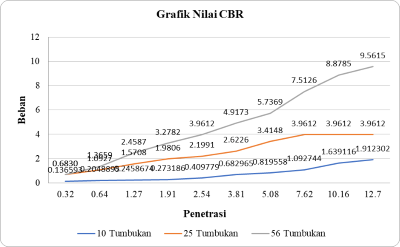Analysis of Soil Bearing Capacity in Kauman, Tulungagung as a Subgrade For Flexible Pavement
DOI:
https://doi.org/10.24036/cived.v11i2.591Keywords:
Soil Bearing Capacity, Soil Stability, CBR Design, Subgrade, Flexible PavementAbstract
This research aims to evaluate the bearing capacity of the soil in Kates Village, Kauman District, Tulungagung Regency, as a subgrade in flexible pavement through California Bearing Ratio (CBR) testing in the Civil Engineering Laboratory of Kadiri University. The tests were conducted with 56, 25, and 10 blows to determine their impact on the soil's density, strength, and stability. The results showed that soil with 56 blows had the highest CBR value of 28.660% at a 5.08 mm penetration, indicating excellent bearing capacity. The soil with 25 blows showed a CBR value of 17.060%, which is quite high, ensuring adequate stability and bearing capacity. Conversely, the soil with 10 blows had the lowest CBR value of 4.094%, indicating the need for additional compaction before being used in road construction. This research confirms that the number of blows has a significant impact on soil quality, with more intensive compaction improving the soil's density and stability. The final design CBR value obtained was 16%, leading to the conclusion that the soil in this area can be used as a subgrade for flexible pavement.
Downloads
References
A. Rafii, “Analisis Perbaikan Tanah Lunak Sebagai Subgrade Jalan,” Jurnal LPPM UGN, vol. 8, no. 3, 2018.
D. O. Dwina, N. Nazarudin, D. Kumalasari, and E. Fitriani, “Stabilisasi Tanah Gambut Dengan Penambahan Kapur dan Fly Ash Sisa Pembakaran Cangkang Sawit Sebagai Subgrade Jalan,” Fondasi : Jurnal Teknik Sipil, vol. 10, no. 1, p. 24, 2021, doi: 10.36055/fondasi.v10i1.10275.
S. A. P. Rosyidi, N. Wukirasih, and S. Siegfried, “Menentukan Modulus Elastisitas Stabilisasi Subgrade Berbasis Defleksi,” Jurnal Rekayasa Sipil (JRS-Unand), vol. 18, no. 1, p. 1, 2022, doi: 10.25077/jrs.18.1.1-16.2022.
A. W. P. Hariadi, A. D. Cahyono, N. A. Fatkunada, Y. M. E. Saputra, and M. R. Susanto, “Identifikasi Karakteristik Tanah Daerah Karangrejo Untuk Subgrade Jalan Raya,” Jurnal Ilmiah Desain & Konstruksi, vol. 22, no. 1, pp. 72–80, 2023, doi: 10.35760/dk.2023.v22i1.8272.
M. Salehi, M. Bayat, M. Saadat, and M. Nasri, “Experimental Study on Mechanical Properties of Cement-Stabilized Soil Blended with Crushed Stone Waste,” KSCE Journal of Civil Engineering, vol. 25, no. 6, pp. 1974–1984, 2021, doi: 10.1007/s12205-021-0953-5.
R. Zentar, H. Wang, and D. Wang, “Comparative study of stabilization/solidification of dredged sediments with ordinary Portland cement and calcium sulfo-aluminate cement in the framework of valorization in road construction material,” Constr Build Mater, vol. 279, p. 122447, 2021, doi: 10.1016/j.conbuildmat.2021.122447.
N. A. Erwanda et al., “Gambaran Sifat Fisik Dan Mekanik Tanah Di Kecamatan Kauman Kabupaten Tulungagung,” Jurnal Riset Rekayasa Sipil, vol. 6, no. 2, p. 84, 2023, doi: 10.20961/jrrs.v6i2.70996.
Y. Yudhyantoro, A. Prayoga, and M. Maimunah, “Analisis Perubahan Volume pada Timbunan Tanah Lempung Berdasarkan Nilai Batas Susut (SNI 3422:2008),” Tameh: Journal of Civil Engineering, vol. 11, no. 2, pp. 114–123, 2022, doi: 10.37598/tameh.v11i2.236.
Badan Standardisasi Nasional, “SNi 1742:2008 Cara uji kepadatan ringan untuk tanah,” Badan Standarisasi Nasional, pp. 1–20, 2008.
E. R. M. Indonesia, “Mlh39-1996.pdf,” pp. 1–13, 1996.
E. Z. Rahmadani, I. Adha, and O. T. Purwadi, “Aplikasi Hasil Eksperimen Pemadatan Tanah Untuk Konstruksi Embung Berdasarkan Metode Tekanan Oleh karena itu , perlu dilakukan studi eskperimen pemadatan tanah untuk kontruksi embung berdasarkan metode tekanan menggunakan alat uji tekan modifikasi untuk m,” vol. 8, no. 2, pp. 259–268, 2020.
S. S. Razouki and D. Kuttah, “Improving Strength by Increased Compaction of Gypsum—Enriched Soil under Long-Term Soaking Conditions,” Geotechnics, vol. 4, no. 2, pp. 415–429, 2024, doi: 10.3390/geotechnics4020023.
S. Y. Amakye, S. J. Abbey, C. A. Booth, and A.-M. Mahamadu, “Enhancing the Engineering Properties of Subgrade Materials Using Processed Waste: A Review,” Geotechnics, vol. 1, no. 2, pp. 307–329, 2021, doi: 10.3390/geotechnics1020015.

Downloads
Published
How to Cite
Issue
Section
License
Copyright (c) 2024 Nadi Rheiza Fathurrohman, Andri Dwi Cahyono, Redyka Sefiyanti, Salman Alfaridh Pasya, Satria Perdana Oktabernandus, Atsfiela Dzulkhan Qalby, Zainal Ichwan

This work is licensed under a Creative Commons Attribution 4.0 International License.







2.jpg)
